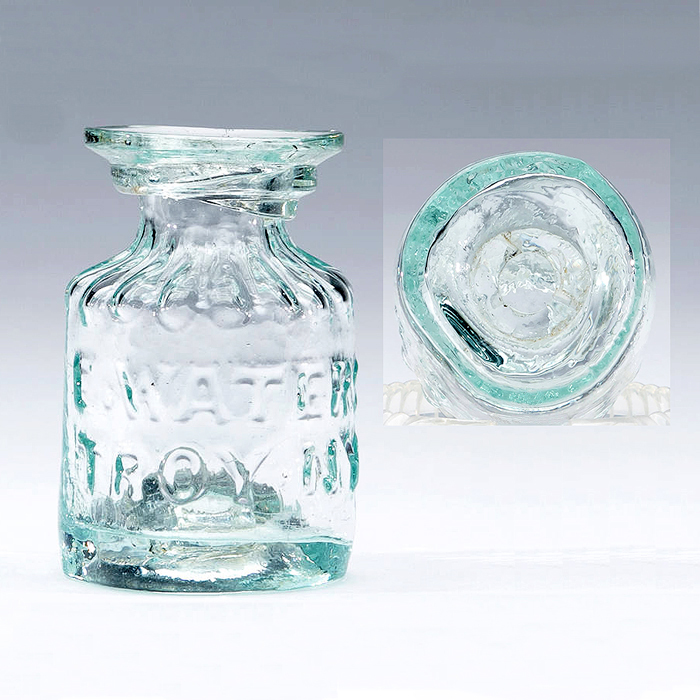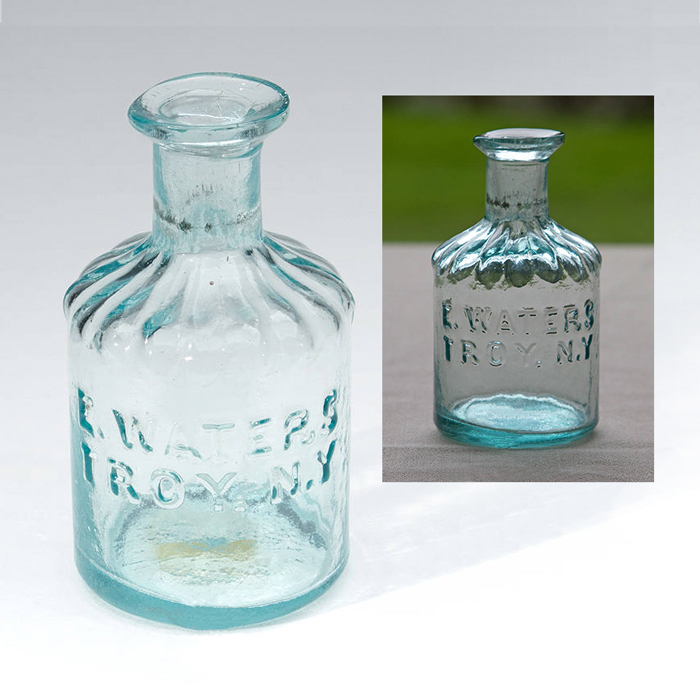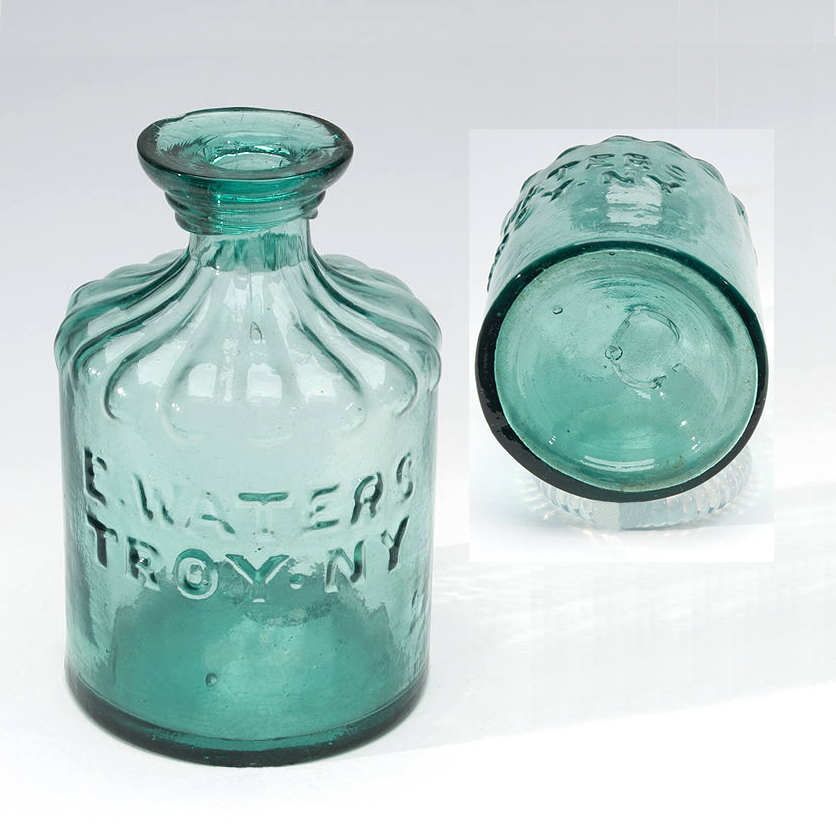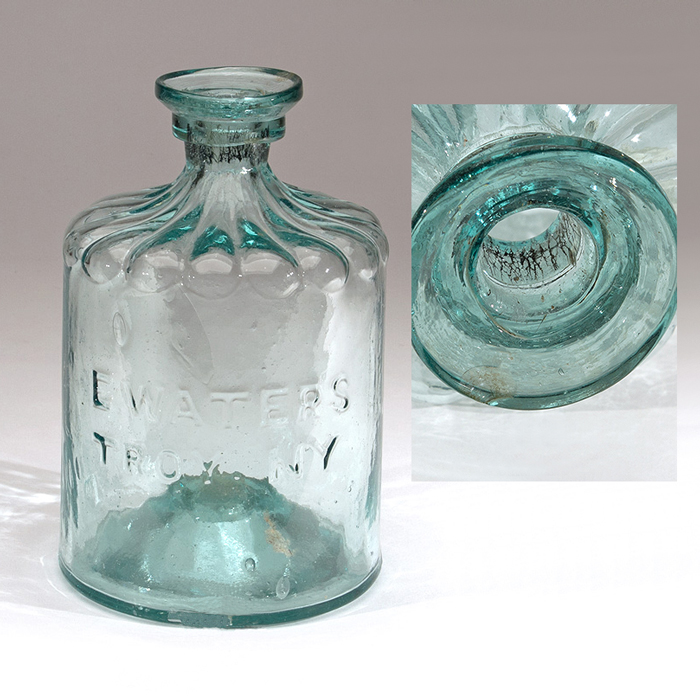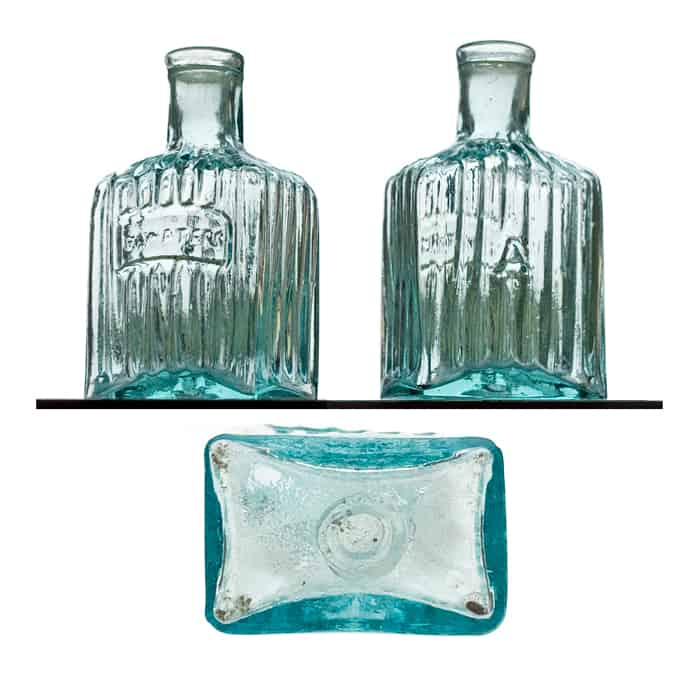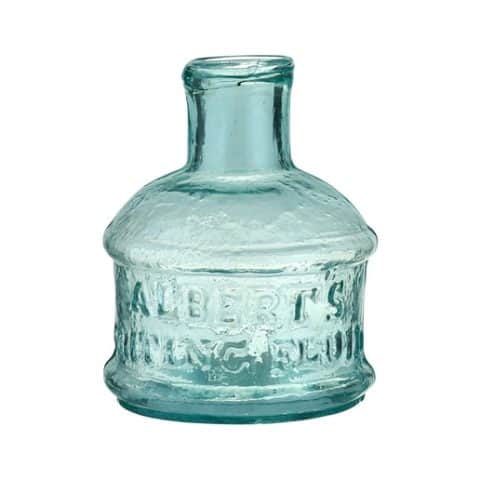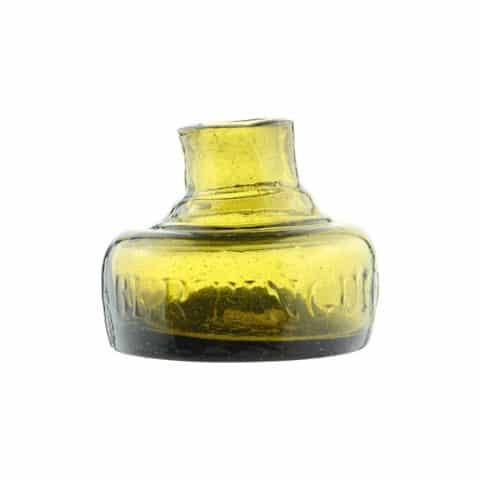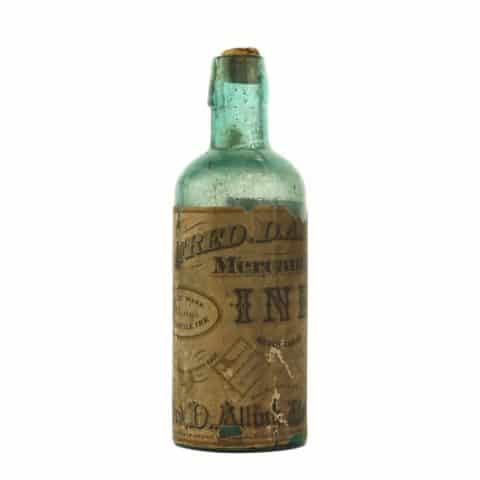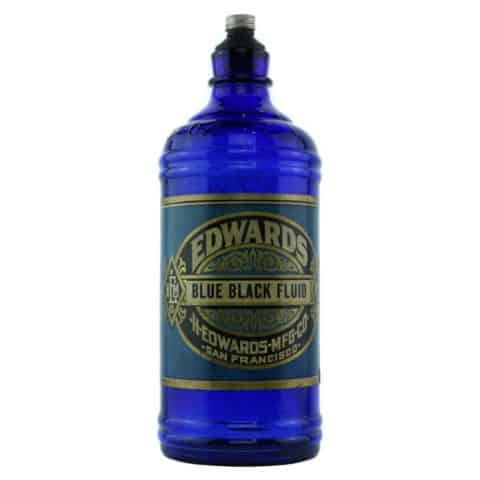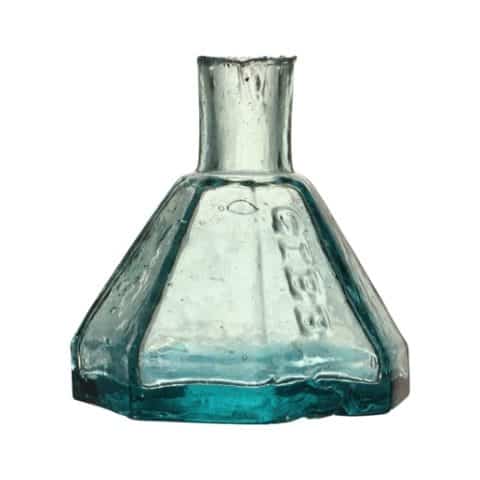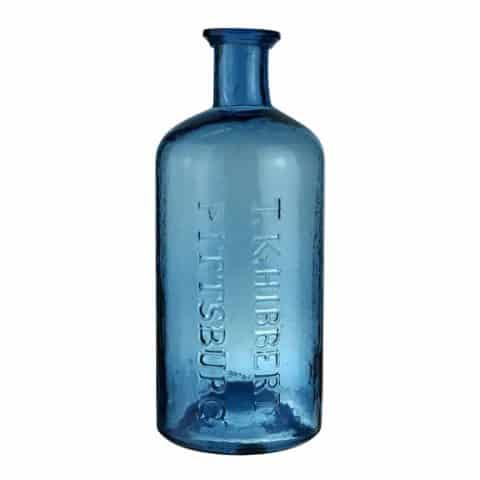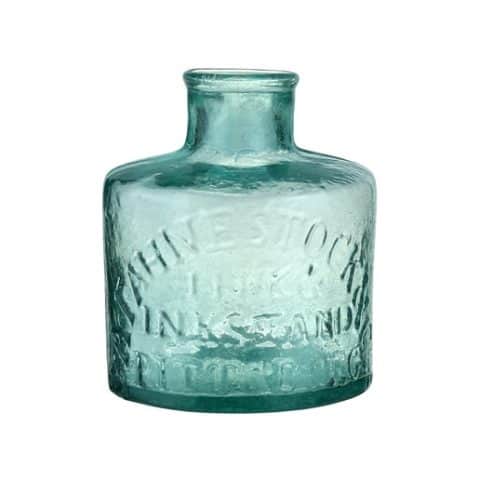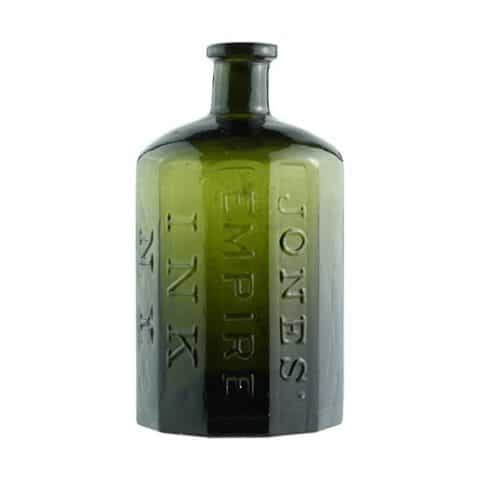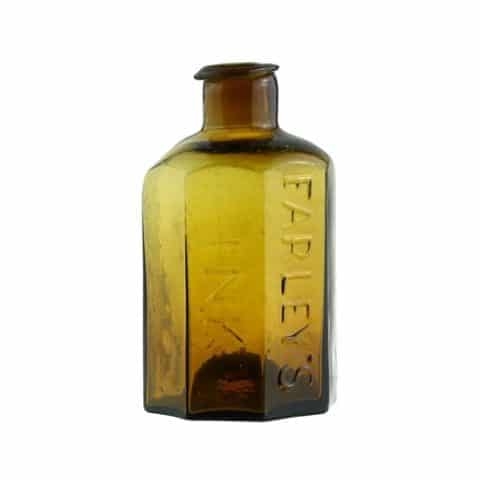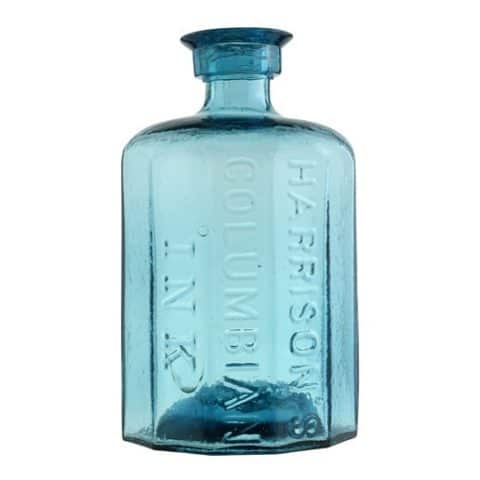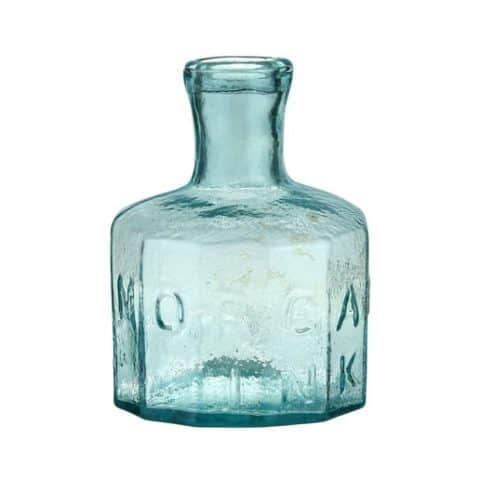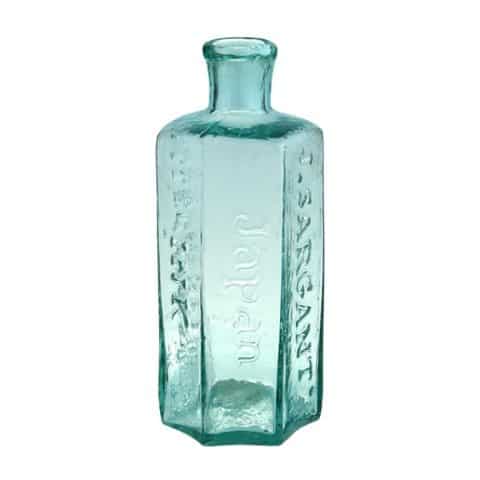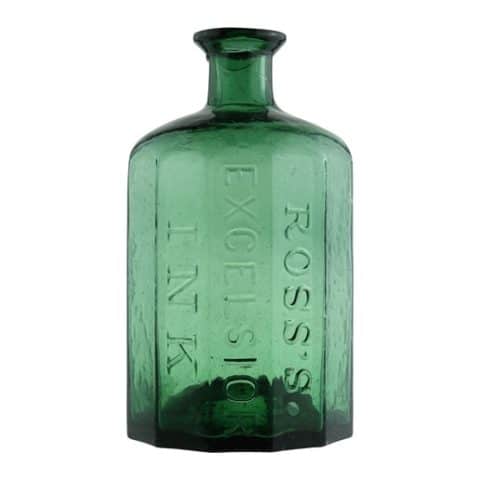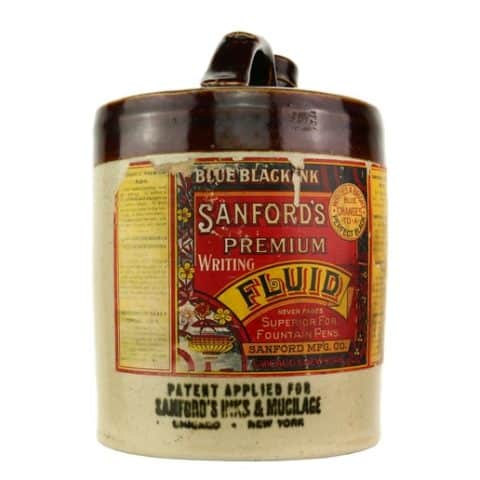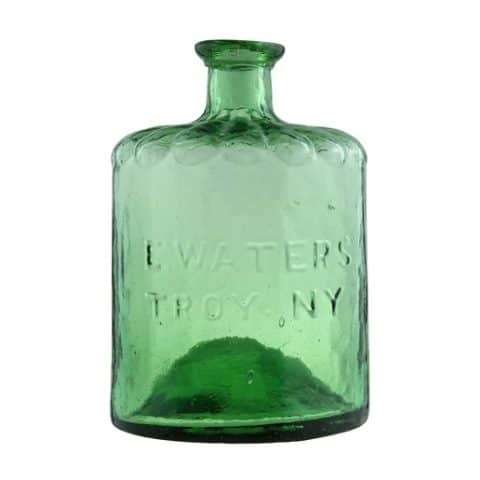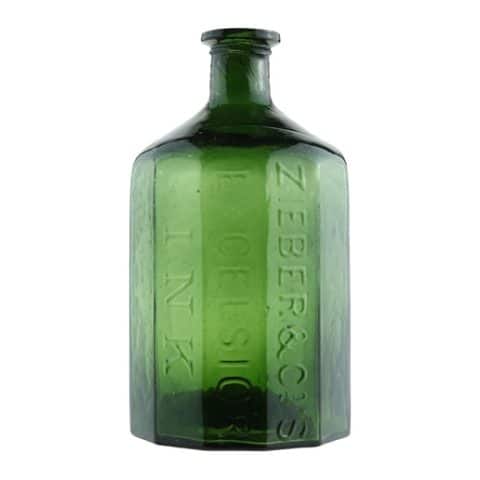Title on Mobile
E. Waters
Troy. NY
Elisha Waters, Troy, New York
Yellow Green Cylindrical Master Ink
Provenance: Michael George Collection
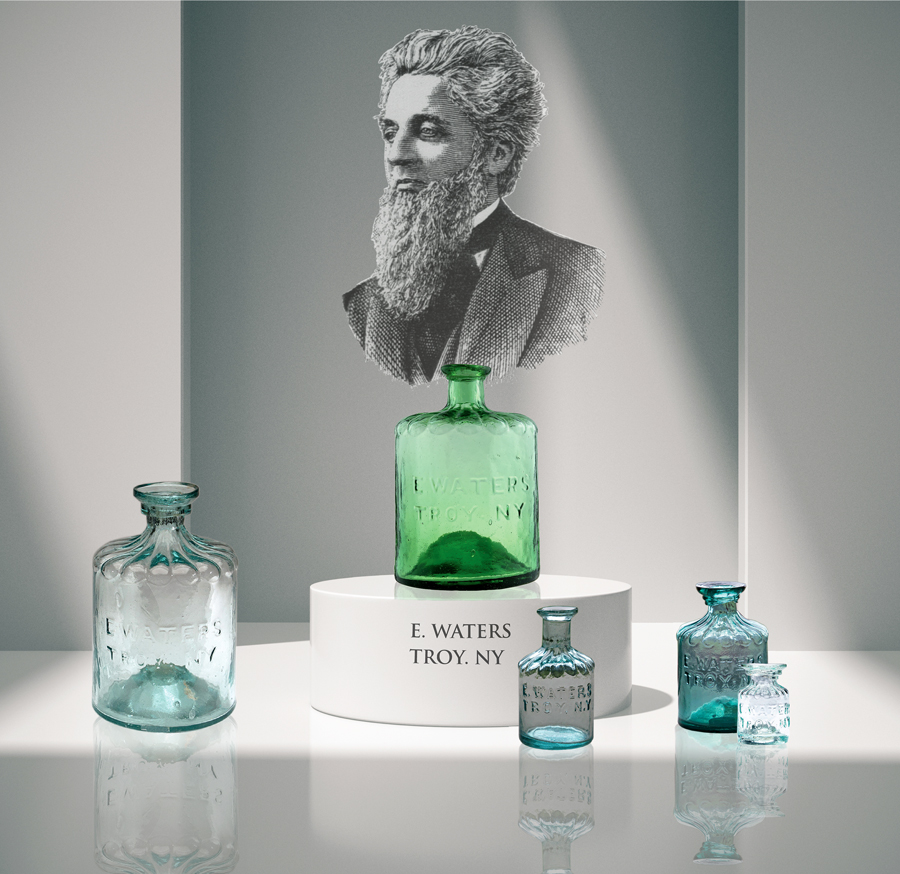
Our example represents an extremely rare, “E. Waters Troy. NY” master ink bottle which was hand-blown in an extraordinarily brilliant, clear yellow-green glass. Elisha Waters ink bottles can be found in many sizes, typically in aquamarine glass, and are recognizable by their cylindrical shape and design with the fluted, tear-drop shoulders and applied flange mouths. The pontiled ink bottles are very sought after by ink collectors.

The subject master ink bottle is cylindrical with fancy fluted, tear-drop shoulders. There is a large applied flanged mouth and an iron pontil scar on the bottom. Two lines of horizontal embossed sans-serif copy reading, “E. WATERS’ (1st line) and ‘TROY. NY’ (2nd line) occurs on the face of the bottle. The bottle is 6 ¼ inches tall and near mint. The reverse is blank and may have been where a paper label was placed.
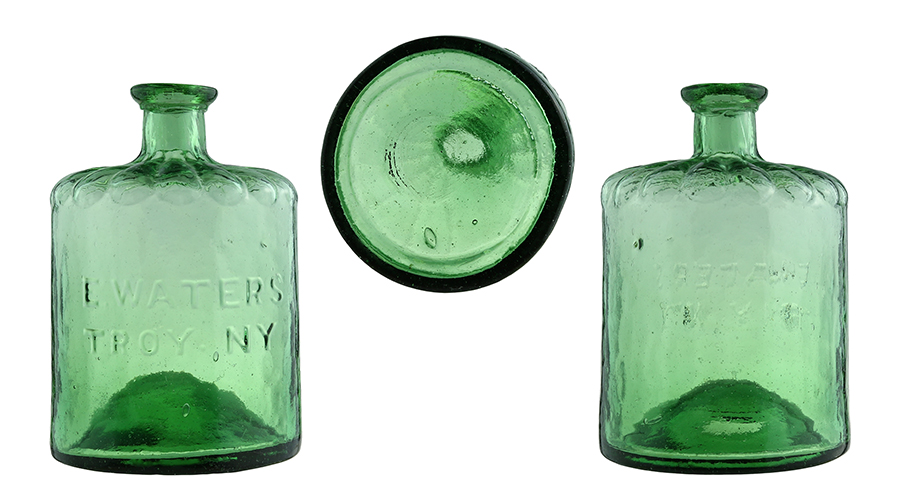
This rare and beautiful master ink is nicely whittled and has great clarity and outstanding color. It was once in the Ed and Kathy Gray collection. Our museum example last made a public appearance in an American Glass Gallery auction in 2012. John Pastor, the auctioneer, noted in the lot write-up that it is believed to be possibly the finest example known to date and that virtually all examples of this impressive, ornate master ink have some form of damage.
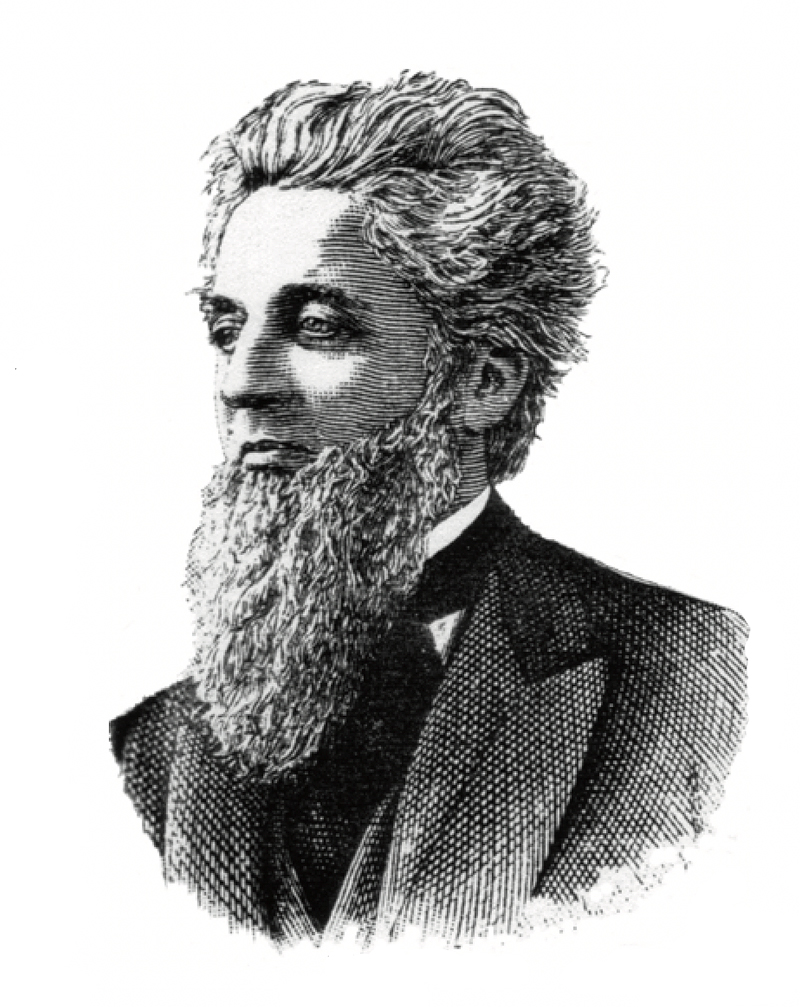
Elisha Waters was born in Bennington, Vermont, in 1815. He was educated in the public schools of Bennington but moved with his parents to Troy, New York, in 1831. Shortly after that, Elisha entered the employ of Oliver C. Hull, a druggist on River Street. When Mr. Hull moved to New York City, Waters got a job with Fassett and Selden, another well-known drug company in Troy. He was such a hard worker that the owners, offering their support, advised him to start his own business when he turned twenty-one.
At first, Elisha Waters planned to head west to Ohio to start a business, but after traveling through Ohio and other western states, he decided to return to Troy. Once again, he got a job with another druggist before opening his first store, in 1838, at the corner of River and Second Streets.
Waters later went into business with Jared S. Weed, and the company was known as Weed and Waters. (Note: This is the spelling in the obituary. An 1850s ad spells the “Weed” name “Wickes.”) This venture at 271 River Street was unsuccessful, and Waters returned to operating his druggist business again. Later, he and John Van Schaick purchased another drug store, and when Mr. Van Schaick retired, Waters took complete control of the company. He made various drug articles, such as Waters Pulmonica (a cough medicine), ink, hair dye, and blacking. The ink bottles are often found, but blacking and hair dye bottles are also known.
By 1852, Elisha Waters was a very successful businessman who needed good packing boxes for shipping his ink and drug products. The paper boxes at the time were flimsy and not very good for heavy items. Waters set to work making a better box and obtained patents for at least two improved boxes, the first in 1855. In the beginning, these were just for his products, but as word spread, other companies wanted to order from Elisha Waters. This development led to a box factory in 1857, producing on a large scale for the shirt, collar, and hosiery industries to name a few. Waters obtained several other patents involving paper products in the next twenty years. By this time, he had sold his druggist business.
Records show Elisha Waters was active during the Civil War manufacturing 4,000,000 cartridge boxes and 65,000 saddle trees for the Union forces. The War Department also engaged him to inspect saddle tree manufacturing plants elsewhere. Waters was a strict Northern supporter, having been a strong Abolitionist before the war. He was a member of the Whig Party until the birth of the Republican Party, becoming a strong supporter of their policies and principles. He never held public office but was active in a few organizations, including the fire company, and he worked to bring the first steam fire engine to Troy. He was also interested in scientific progress, particularly in aeronautics, having taken a balloon ride from Troy to Pittsfield, Massachusetts. Although continuing to manufacture paper boxes, his creative mind helped him make many innovations in the process and methods of paper manufacturing. One of these inventions was a paper can for oil and other liquids in 1877, for which he obtained a patent.
Searching for new product lines, Elisha worked with his son George A. Waters, who invented the paper racing boat shell, which attained worldwide fame. They obtained a patent for the construction of a paper boat in 1868 and their first boat was dubbed “The Experiment.” Elisha had much practical knowledge in the manipulation of paper that helped make George’s boat a success. These waterproof paper boats were lighter and faster and won many races and were popular with college crews and most professional oarsmen.
Waters was selling so many that he had to build a factory to manufacture just these boats. The firm was first called Waters and Balch, later just E. Waters & Sons located in Lansingburg just north of Troy.
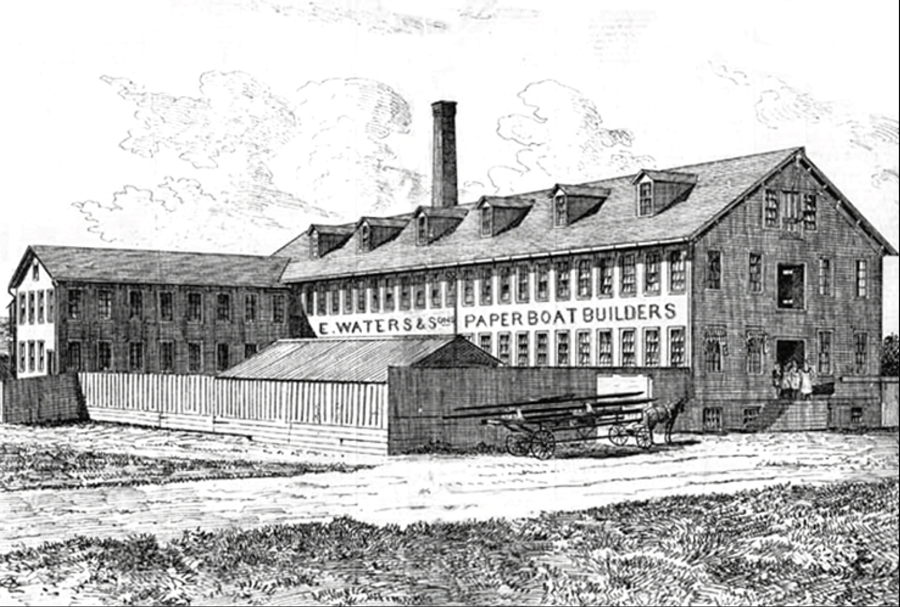
These boats were popular because rowing competitions were a big sport in the last quarter of the 19th century. Waters’ catalog proudly said a total of 14 races were won by his paper boats in 1868 and 26 in 1869. By the 1870s and 80s, many were competing for prizes of several thousand dollars, a big prize in the 1880s. Some say it was scandals resulting from gambling that caused the demise of paper boat racing. It was mostly because the shells were flimsy and eventually the oarsmen returned to wood. It was strong, and its greater weight was not enough of a handicap to overcome its admitted values.
Interestingly enough, a new experiment was announced about the same time as an Oxford crew in England had adopted glass for their boats and were rowing up and down the little river Isis. The initial reports were optimistic as the boats were light, speedy, and maneuverable. A newspaper at the time said “The big question is whether it will be safe in rough water. In still water, it runs splendidly, without any need of varnish. The fibre glass is so smooth that it seems perfect, is easily repaired, and will not split if punctured, as will cedar. We will find out how good the glass boat is when it is tried on the Thames.”
While boat building was the main interest of George Waters, Elisha was always looking for new things to do with paper. In 1878, he built a paper observatory dome at Rensselaer Polytechnic Institute in Troy. The construction was almost identical to the paper boat construction. They first built a framework which they bolted together, and the joints were weatherproofed with a cotton cloth saturated with white lead. This dome lasted for twenty years. It was removed when the building was converted to other uses, not because of decay. Several other domes were built, including one for the U.S. Military Academy at West Point. It contained over 2,000 pounds of paper and was 30 feet in diameter. This dome fell into disrepair and was dismantled in 1958/59.
In 1901, a fire destroyed the boat and dome factory, and the business never reopened. It was stated at the time, that the fire caused $20,000 in damage, and they had only $ 5,000 in insurance. This, plus age, health, and competition, was probably the reason. Both George and Elisha died within two years of the fire. Another son, Clarence W. Waters, who had worked with them, was still living. C. W. Waters is listed on some of the patents obtained by this firm. Waters may have been responsible for the many paper patents obtained by others who tried to emulate his success. Patents included paper stools, a paper casket, and even a paper locomotive wheel.
Elisha Waters’ obituary says he was genial, pure-minded, and never lost an opportunity to help his fellow man. In business, he was intelligent and determined but honest, a family man cherishing moments with those he loved. His life and career history could be summed up with two words—Well Done. He died on January 28, 1904.
Primary Image: E. Waters Troy. NY master ink bottle imaged on location by Alan DeMaison, FOHBC Virtual Museum Midwest Studio
Support: Primary reference and use of Elisha Waters, More Than Just An Ink Maker by Ed and Lucy Faulkner, FOHBC Bottles and Extras, Summer 2006.
Support: Reference to Ink Bottles and Inkwells, William F. Covill, Jr., 1971
Support image: Auction Lot 67: “E. Waters / Troy. NY” Master Ink Bottle. America, 1845 – 1855. Brilliant clear yellowish-green, cylindrical with fancy fluted shoulders, large applied flanged mouth – iron pontil scar, ht. 6 ¼”, near mint; (a minor, 1/8” flake on the edge of the applied mouth and a small, pinhead-size potstone on the reverse with a tiny, 1/8” flash). C#774. An extremely rare and beautiful master ink, nicely whittled, with great clarity and outstanding color. Ex. Ed & Kathy Gray collection. “it is believed to be possibly the finest example known to date.” Note: it is believed that virtually all examples of this impressive, ornate master ink have some form of damage. The flaws on this one are extremely minor and it is believed to be possibly the finest example known to date. – John Pastor, American Glass Gallery, Auction #9, November 2012.
Support image: Auction Lot 249: “E. Waters / Troy. NY” Ink Bottle, America, 1840-1860. Cylindrical with fluted shoulders, aquamarine, applied flared mouth – tubular pontil scar, ht. 2 1/4 inches, dia. 1 3/8 inches. C #207 This little gem is appealing in both size and form. Fine condition. – Norman Heckler Jr. & Sr., Norman C. Heckler & Company, Auction #195
Support image: Auction Lot 191: “E. Waters / Troy, N.Y” Master Ink Bottle, America, 1860-1870. Cylindrical with fluted shoulders, aquamarine, applied flared mouth – smooth base, ht. 3 7/8 inches, dia. 2 1/8 inches. C #208 A scarce and desirable ink bottle. Fine condition. Bill Dyer collection. – Norman Heckler Jr. & Sr., Norman C. Heckler & Company, Auction #170
Support image: Auction Lot 126: “E. Waters / Troy. NY” Master Ink Bottle, America, 1840-1860. Cylindrical with fluted shoulders, clear light green, applied flared mouth – pontil scar, ht. 4 1/8 inches. C #208 An interesting little bottle with bold embossing and attractive fluted shoulders. Fine condition. Charles and Joy Flint collection. – Norman Heckler Jr. & Sr., Norman C. Heckler & Company, Auction #158
Support image: Auction Lot 91: “E. Waters / Troy. NY” Master Ink Bottle, America, 1840-1860. Cylindrical with fluted shoulders, aquamarine, applied flared mouth – pontil scar, ht. 6 5/8 inches; (1/8 inch chip with surrounding 3/8 inch bruise on mouth edge). Similar to C #774 With the exception of the mouth problem, this is an eye-appealing example. – Norman Heckler Jr. & Sr., Norman C. Heckler & Company, Auction #119
Support image: Auction Lot 106: “E. WATERS” – “A” Ink Bottle, America, 1845 – 1855. Bright aquamarine, rectangular with vertical ribbing, sheared and inward rolled mouth – blowpipe pontil scar, ht. 3 ¼”, perfect! Faulkner, p.146. A rare little ink from the Elisha Waters company, druggist and ink manufacturer, Troy, NY. Bright, clean and sparkling, a very attractive example. – John Pastor, American Glass Gallery, Auction #32
Join the FOHBC: The Virtual Museum is a project of the Federation of Historical Bottle Collectors (FOHBC). To become a member.


